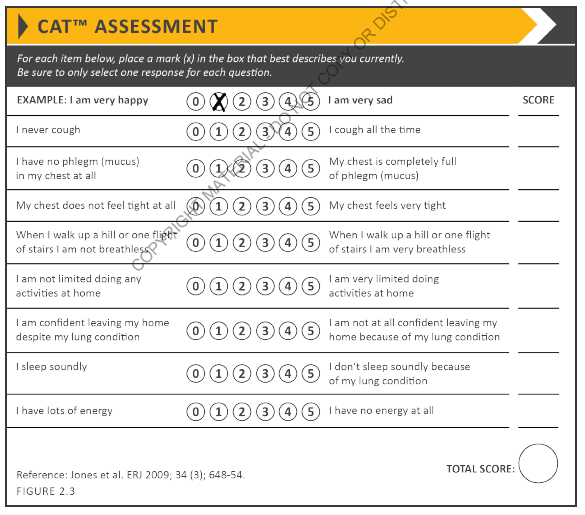9.1 Chronic Obstructive Pulmonary Disease (COPD)
Learning Outcomes
Be able to:
- Describe the symptoms of COPD
- List the risk factors for COPD
- Explain the pathophysiology of COPD and how it differs from the pathophysiology of asthma
- Describe the principles of managing COPD, including drug treatment options
- Access and use the COPDx and GOLD guidelines.
Chronic Obstructive Pulmonary Disease (COPD)
Key Resources for Further Reading
Note that the documents linked below are very long. You are not expected to read these documents in their entirety. However, you may find it especially helpful to read the COPDx handbook.
The COPDx Guidelines are produced by the Lung Foundation Australia’s COPD Guidelines Committee. Attached below are a concise guide and the complete guidelines. These are also available at: https://lungfoundation.com.au/health-professionals/conditions/copd/overview/
The GOLD Guidelines are produced by a committee of international experts. These are also available at: https://goldcopd.org/
Part 1: Introduction to COPD
COPD is an obstructive lung disease characterised by expiratory airflow limitation.
The following video from the National Heart Lung Blood Institute in America provides a nice graphical representation of the basic pathophysiology of COPD.
📺 Watch this video about the basic pathophysiology of COPD (3:53 minute)
- Fast forward to 2mins 3seconds, and watch to the end. The video is also available at: https://youtu.be/_obAlFbZDbY.
📺 Watch this video about how normal lungs function (4:35 minute)
This video provides a useful depiction of the damage to the alveoli seen in patients with emphysema.
- The video is also available at https://youtu.be/T1G9Rl65M-Q
Cigarette smoking is the most important risk factor for COPD. The figure below is from the Therapeutic Guidelines (Respiratory). It shows that progression to disability and death is so much quicker among patients who smoke regularly, compared to if they were stop smoking at age 45. The trajectory to disability is slowed significantly when smoking cessation is achieved at age 45.

📺 Watch Part 1 of the Lecture on Chronic Obstructive Pulmonary Disease (COPD) (8:09 minute)
Download resources here
Part 2: Diagnosis and Treatment of COPD
The diagnosis of COPD is usually based on a:
- History of smoking OR
- Exposure to another noxious agent PLUS
- An FEV1/FVC <0.7 post-bronchodilator
Once a diagnosis of COPD is made, the severity of the COPD is assessed by taking into account not only lung function, but also the patient’s history of exacerbations, and comorbid conditions.
The COPD Assessment Test (or CAT) is referred to in both the Australian COPDx and the international GOLD guidelines. It can be used by the patients multidisciplinary team to determine the impact of their COPD symptoms on their wellbeing and activities of daily living.
- GOLD COPD website. https://goldcopd.org/


Management of COPD
As is the case with most disease states, COPD treatment includes both non-pharmacological and pharmacological measures.
Remember that smoking cessation is the only intervention shown to improve the natural course of COPD. Smoking cessation is the most important treatment intervention!
There is also strong evidence for the benefits of pulmonary rehabilitation. That is, supervised exercise training alone or in combination with patient education and other non-pharmacological interventions such as nutritional interventions and psychosocial support systems.
Patients should be encouraged to exercise for at least 30 minutes each day, remain up-to-date with their vaccinations, and utilise a COPD action plan.
Inhalers comprise the mainstay of pharmacological therapies used to treat COPD. We use inhalers with the aims of relieving symptoms and preventing deterioration. Use of these inhaled drugs aims to reduce symptoms and prevent exacerbations by targeting the pathophysiology of COPD.
A ‘stepwise management of COPD algorithm’ has been developed by the Lung Foundation Australia. This is our ‘go-to‘ resource for managing COPD in practice. The figure below is an excerpt of this algorithm. You should refer to the complete document linked below and aim to develop a comprehensive understanding of this content.

Essential Resources for Download
1. Stepwise COPD Management available at https://lungfoundation.com.au/resources/stepwise-management-of-stable-copd/
2. Current Available Inhaler Devices for COPD Poster Chart available at https://lungfoundation.com.au/resources/copd-inhaler-device-chart-poster/
COPD Exacerbations
An exacerbation of COPD is an acute worsening of COPD symptoms (e.g., increasing dyspnoea, tachypnoea, more coughing, and more sputum production). Early detection and treatment of COPD exacerbations is important for preventing longer-term deterioration, because exacerbations of COPD are associated with accelerated loss of lung function, even in patients with mild disease.
First line treatment for COPD exacerbations include the short acting bronchodilators – SABAs and SAMAs.
Oral corticosteroids are also indicated for use in COPD exacerbations. Commonly, patients will be prescribed a dose of prednisolone 30-50mg each morning with breakfast for 5 days.
Lastly, it is important to understand when antibiotics are indicated for COPD exacerbations. Remember that COPD exacerbations can be triggered by viral or bacterial infection, or a variety of non-infective causes. Antibiotics are only indicated for exacerbations with signs and symptoms consistent with a bacterial infection.
Refer to the ‘managing COPD exacerbations’ algorithm linked below and aim to develop a comprehensive understanding of this content.
Resources
The following resource provides a useful algorithm for identifying and managing COPD exacerbations, available at https://lungfoundation.com.au/wp-content/uploads/2018/12/Information-Paper-Managing-exacerbations-algorithm-Dec2018.pdf
A COPD Action Plan template is provided below. Available at: https://lungfoundation.com.au/resources/copd-action-plan/
📺 Watch Part 2 of the Lecture on Chronic Obstructive Pulmonary Disease (COPD) (33:42 minute)
The second part of this lecture video discusses the diagnosis, non-drug and drug treatment and management of COPD exacerbations.
COMMONWEALTH OF AUSTRALIA Copyright Regulations 1969 WARNING
This material has been reproduced and communicated to you by or on behalf of James Cook University in accordance with section 113P of the Copyright Act 1969 (Act).
The material in this communication may be subject to copyright under the Act. Any further reproduction or communication of this material by you may be the subject of copyright protection under the Act. Do not remove this notice.
